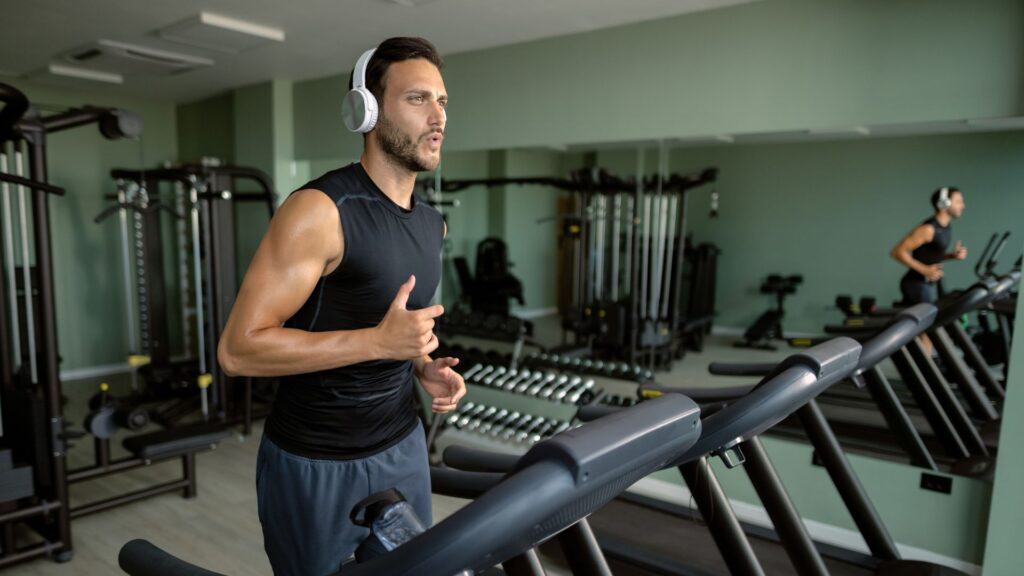If you have your sights set on conquering the Toyo Marathon but find yourself limited to training on a treadmill, fear not!
With the right approach, you can still prepare yourself for the Tokyo marathon and achieve your marathon goals by doing the majority of your training on the treadmill. Treadmill training offers a consistent and reliable way to build your endurance, providing you with an advantage when it comes to race day.
In this blog post, we’ll dive into effective treadmill training methods, address common challenges, and offer tips to make the most of your training sessions.

What Are The Benefits Of Treadmill Training
Treadmill training offers many benefits for runners aiming to enhance their fitness, endurance, and heart health.
Whether you’re a beginner or a seasoned athlete, using treadmill workouts as part of your exercise routine can provide various benefits:
1. Easy Access
Treadmills provide a simple way to train indoors, allowing you to exercise no matter the weather or time limitations. This accessibility encourages a consistent workout schedule and eliminates the need for outdoor running spaces.
2. Controlled Environment
Treadmills offer a predictable workout setting, enabling you to adjust various factors like speed, incline, and workout duration. This feature is especially helpful for people recovering from injuries or those who want to monitor and manage specific training variables.
Additionally, the controlled indoor environment ensures a consistent temperature throughout your workout, providing comfort and eliminating weather-related concerns.
3. Reduced Joint Impact
The soft surface of a treadmill absorbs the shock of each step, lessening the strain on your joints and lowering the risk of injury compared to running on hard outdoor surfaces. This aspect makes treadmill training suitable for individuals with joint sensitivity or those prone to overuse injuries.
4. Safety Measures
Treadmills often come with safety features such as emergency stop buttons and safety clips, ensuring your well-being during intense workouts. These features offer a sense of security, especially for individuals exercising alone or those with specific health concerns.
5. Monitoring and Tracking
Most modern treadmills include advanced monitoring systems that track essential workout metrics like heart rate, distance, calories burned, and pace. This data can help you keep track of progress, set achievable fitness objectives, and adjust your training plan accordingly.
6. Weight Control
Treadmill training can serve as an effective tool for managing weight and burning calories. By integrating interval training and varying incline levels, you can burn a substantial number of calories during each session, contributing to weight loss and overall body shaping.
7. Diverse Exercise Options
In addition to running, treadmills offer versatility in workout choices, including walking, jogging, and sprinting. Many models also incorporate features for cross-training activities like walking uphill, lateral shuffling, and walking backwards, providing a comprehensive approach to cardiovascular conditioning and muscle involvement.
How To Train For The Tokyo Marathon On A Treadmill
If you’re planning to utilize a treadmill as part of your marathon training regimen, it’s essential to consider several critical factors.
By focusing on these aspects, you can optimize your training experience and derive the most benefit from this valuable tool:
- Replicating Outdoor Running
- Doing Treadmill Speed Workouts
- Doing Your Long Runs On The Treadmill
- Staying Hydrated While Training
- How To Recover After Training
How To Replicate Outdoor Running On A Treadmill
Experienced runners often emphasize the contrast between running on a treadmill and running outdoors, and they are right—these two environments are distinct.
When you run on a treadmill, you miss the wind resistance that naturally occurs when running outdoors. However, there’s a way to more effectively replicate the outdoor running experience on a treadmill.
To closely mimic the energy expenditure of outdoor running, researchers recommend setting the treadmill’s incline to 1%.
This slight elevation compensates for the absence of wind resistance and brings you closer to the experience of running outdoors.
But here’s a little secret: while the 1% incline is a helpful adjustment, it doesn’t fully replicate the entire outdoor running experience.
Running on a moving treadmill belt introduces some unique biomechanical considerations that should also be taken into account.
What You Need To Know About Running on an Inclined Treadmill
There’s more to be gained from incorporating a slight incline into your treadmill workouts than just compensating for the lack of wind resistance.
When transitioning from outdoor to treadmill running, it’s crucial to recognize a few key differences, notably the distinct roles of your glutes and hamstrings in propelling you forward with each stride.
During outdoor running, your glutes and hamstrings play a significant role in generating the necessary effort for forward propulsion.
However, when running on a treadmill, the continuously moving belt can assist in this propulsive work, thereby reducing the demand on those muscle groups.
To bridge this gap and better simulate the experience of outdoor running, it’s recommended to start with a 1% incline for your ‘flat’ treadmill runs. As you progress, you can gradually increase the incline to approximately 3%.
It’s important to note, however, that individual preferences and fitness levels vary, so finding the right incline for you is key
If you’re new to treadmill running or are a beginner, starting with a 1% incline and gradually progressing to 3% is advisable. Additionally, if running at a 3% incline feels too challenging, you can lower it to 2% or a level that feels more manageable for you.
Listen to your body and make adjustments accordingly.
This slight incline encourages more active engagement of your glutes and hamstrings, effectively preparing your legs for the demands of outdoor running, especially during a marathon.
For individuals experiencing knee pain, especially with conditions such as patellofemoral syndrome, incorporating an incline into treadmill workouts can be particularly beneficial. Uphill running naturally discourages over-striding, which can help alleviate stress on the knees and potentially prevent discomfort.
Remember that when you introduce extra incline into your treadmill workouts, you may need to modify your pace. Prioritize effort over a specific speed, as the incline inherently increases the difficulty of your workout.

Which Treadmill Workouts To Do For Your Tokyo Marathon Training
Incorporating treadmill workouts into your Tokyo Marathon training plan can significantly benefit your overall preparation.
Treadmills offer a controlled and convenient environment for training, providing various workout options that can enhance your speed, endurance, and overall performance.
But which treadmill workouts should you do to prepare for the Tokyo Marathon?
Long Runs
Long runs are an essential component of your training plan, serving to develop and improve your endurance.
These runs play a crucial role in enhancing your running economy by training your body to adapt to longer distances, both physically and mentally.
When conducting treadmill training, it’s essential to make a slight adjustment.
Follow the pace recommended in your training plan while setting the treadmill to a 1% incline. Keep in mind that treadmill models can vary, and pacing may differ slightly.
Therefore, focus on maintaining an easy effort level rather than relying solely on external measurements.
Interval Training & Hill Intervals
Interval training and hill intervals are highly effective methods for improving endurance, speed, and running economy.
Interval training involves alternating between periods of rest and intense running, while hill interval sessions focus on enhancing muscular and cardiovascular strength by incorporating inclines into your running routine.
These workouts can significantly boost your overall running performance.
When performing interval training on a treadmill, it’s recommended to keep the incline at 0% for most intervals. However, for hill intervals, you should gradually increase the incline to 3-5% as you progress.
Adjust the intensity based on the level of challenge, and don’t hesitate to slow down if needed.
Prior to starting your training session, it’s crucial to ensure a proper warm-up. A suitable warm-up includes easy running, builds, strides, and running drills. Dynamic stretching can also be incorporated into your warm-up routine.
For intense training sessions such as intervals, hills, track work, or time trials, allocate 15–20 minutes for a thorough warm-up, including dynamic stretching.
On the other hand, for easy, recovery, and long runs, a 5-10 minute gentle warm-up is generally sufficient before settling into your stride.
Time Trials
Time trials are crucial for monitoring your progress and making any necessary adjustments to your training plan. Typically scheduled every four to six weeks, these trials serve as benchmarks for your performance and provide valuable insights into your development.
Depending on your target race distance, time trials can be either 5 miles or 8 km in length. It’s important to give your best effort during these trials to gauge your current capabilities accurately.
When conducting time trials on a treadmill, it’s advisable to set the incline to 1%. This slight incline helps replicate outdoor running conditions, providing a more accurate representation of your performance.
Long runs are a vital aspect of marathon training on a treadmill. Although challenging, these extended sessions play a critical role in building endurance and preparing your body for the demands of the race.
It’s essential to approach long runs strategically and incorporate proper pacing and incline adjustments to simulate outdoor running conditions effectively.
Let’s take a deep dive into this…
Doing Your Long Runs On The Treadmill
When training for a marathon on a treadmill, completing your long runs is a critical component, much like in outdoor training. The duration of your longest training run for a marathon will vary based on your experience level and specific goals.
It’s essential to not only focus on the running aspect but also pay attention to your nutrition. Ensure you have all your necessary supplies with you, minimizing the need for long breaks to fetch food or necessities. Proper preparation ensures a smoother and more effective long run on the treadmill.
If you’re a first-time Tokyo Marathon runner, you can refer to our comprehensive guide to ensure successful marathon training.
Treadmill running can sometimes feel monotonous compared to the dynamic experience of running outdoors.
To combat this, consider using distractions such as audiobooks, podcasts, music, or even TV shows to keep your mind engaged during long runs.
Better yet, why not let us help you pass the time? Check out our YouTube channel here.
One notable advantage of doing your long runs on a treadmill is the easy access to drinks and nutrition.
Unlike outdoor runs where you need to carry your supplies, the treadmill allows you to keep everything within reach, ensuring you stay adequately fueled and hydrated throughout your run.
During long marathon training sessions on the treadmill, it’s essential to incorporate regular walk breaks, similar to what you would do during outdoor runs.
These brief intervals provide moments of recovery, help reduce the risk of overexertion, and contribute to overall endurance and performance.
Staying Hydrated While Training
Maintaining proper hydration is a critical aspect of your running routine that should never be overlooked.
It’s easy to become absorbed in your training and forget to replenish your fluids, but doing so is vital for sustaining optimal performance and reducing the risk of heat-related complications.
Here are some essential strategies to keep in mind:
Before training: Consume a well-balanced meal or snack rich in carbohydrates and protein before starting your treadmill workout. This combination provides the necessary energy and nutrients for sustained performance during your training session.
During training: Keep a water bottle within easy reach while running on the treadmill and take regular sips to maintain hydration levels and prevent dehydration. For longer runs, consider incorporating electrolyte-rich beverages or sports drinks to replenish lost minerals and optimize performance.
After training: Focus on post-workout nutrition to aid in muscle recovery once you’ve finished your treadmill workout. Consume a snack or meal containing a mix of carbohydrates and protein to replenish glycogen stores and promote muscle repair.
How To Recover After Your Treadmill Training
After you finish training on the treadmill, it’s essential to help your body recover properly to avoid injuries. Here’s what you can do:
Cool Down and Stretch: After your workout, take some time to cool down and then do some gentle stretching exercises. This can help your muscles relax and become more flexible.
Eat Well for Recovery: Focus on eating foods that can help your muscles repair themselves. Foods like lean meats, beans, and dairy products are good sources of the stuff your muscles need to get stronger.
Drink Enough Water: Drink plenty of water to stay hydrated, especially after you’ve been sweating a lot. You might also want to try drinks that have electrolytes in them, like sports drinks.
Get Enough Rest: Make sure you take days off to let your body rest. Getting a good night’s sleep is also crucial for helping your muscles recover and making sure you feel good for your next workout.
It’s crucial to understand that taking care of your body after a workout is just as important as the workout itself. It helps your muscles get stronger and prevents you from getting hurt.
Another important thing to remember while doing your treadmill training is that the best way for you to avoid injury and become a faster, stronger runner is to incorporate strength training into your training.
Exercises like toe raise and forward & lateral band walks, for example, are perfect. Our free strength training plan is a great place to start and you can download it by clicking here.
For your family and friends who plan to come and cheer you on during your marathon, it’s a great idea to share them with this spectator guide.
This guide can help them make the most of the race day experience and ensure they can find you along the course.



Comments are closed.